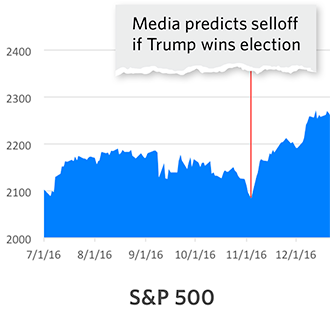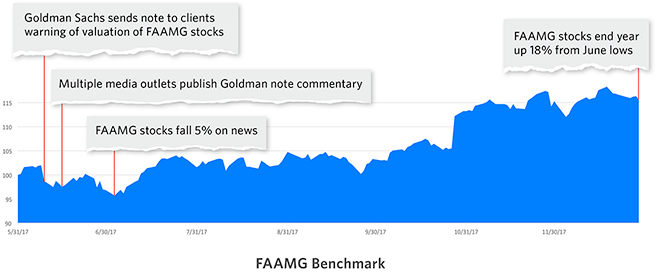As headlines become more sensational, investors should recognize how the 24-hour news cycle can negatively impact long-term returns.
By Mark Stoeckle
May 7, 2018
A world filled with constant news flow can be overwhelming to investors. The media often speaks in absolutes to create sensational headlines to generate the most attention. It is easy for investors to get caught up in the noise, particularly during volatile markets with pronounced swings both up and down. The headlines can raise concerns about prospective threats that could derail the stock market or, alternatively, create a “fear of missing out” by simplifying or overstating more bullish catalysts. Unfortunately, investors who react to the non-stop news can end up selling stocks at the wrong time, which is why investors are often better served to block out the noise created by the news and Stay Invested.
Investors who react to the non-stop news can end up selling stocks at the wrong time, which is why investors are often better served to block out the noise created by the news and Stay Invested.

Looking back over just the past two years, there are many examples of how the media has created a frenzy over news that, in reality and in hindsight, proved to be insignificant. The narrative of most financial news publications leading up to the 2016 U.S. presidential election is an example. A November 2016 article in Barron’s summarized the consensus view among most news organizations with a headline predicting “If Trump Wins: Expect a Swift Selloff in U.S. Stocks.” Of course, we now know that, after a short-lived drop, domestic stocks rallied following the election, fueled by the prospect of tax reform as well as less regulation under the Trump administration.
For those who responded to the headlines leading up to the election or once the results were in by selling stocks, it meant missing the ensuing 6% post-election rally in the S&P 500 in November and December of 2016, and watching from the sidelines as stocks ascended to record highs. According to the 2017 Quantitative Analysis of Investor Behavior (QAIB), an annual report published by market research firm DALBAR, the average mutual fund investor underperformed the S&P 500 Index by 5% during the election year. In their commentary, the researchers attributed the shortfall to widespread fears of a post-election downturn that never materialized.
Something similar occurred in June of last year when a bearish note from Goldman Sachs, which was widely covered across the financial media, helped trigger a temporary rotation out of the FAAMG stocks (Facebook, Amazon, Apple, Microsoft and Google) and the broader technology sector. FAAMG stocks declined 5% on average in June 2017; however, tech shares quickly recouped their losses and by the end of July were up 6% on average and up 18% from the June lows by year-end.
These examples are actually quite common. In a past Insight, we highlighted the tendency for pronounced market swings to be clustered together, making it much more difficult for investors to time the market based on the news cycle. For instance, the revelation that President Trump asked then-FBI Director James Comey to drop an investigation into former National Security Adviser Michael Flynn caused the stock market to drop 2% last May, the largest one-day decline of 2017. It took just three days for the S&P 500 to recover from the drop, and it went on to gain another 13% for the remainder of the year.
Focusing on the endless stream of news and the many emotional outbursts of Twitter, and the potential impact they have on stocks has proven to be ineffective for most retail investors. This is particularly true in an era in which high-frequency trading platforms can make split-second decisions long before market-related news reaches mainstream investors. This is also why many long-term professional investors tend to ignore the non-stop news flow altogether because it merely represents more noise that can distract attention from the signals that really matter. To avoid overreacting to the 24-hour news cycle, we recommend investors consult with their financial advisors and maintain a long-term strategy.
In our earlier Insight, we discussed the many challenges for individual investors who attempt to time the market. In a way, the news cycle encourages this behavior through applying a black-and-white depiction of developments that are more appropriately characterized through shades of gray in terms of whether they positively or negatively impact equity prices.
Professional investors focus on real signals, conveyed through fundamental analysis and economic data, versus the noise that results from a hectic news cycle. And while the headlines on any given day, at any given hour, may scream to either buy or sell, we believe the best strategy is to Stay Invested.




